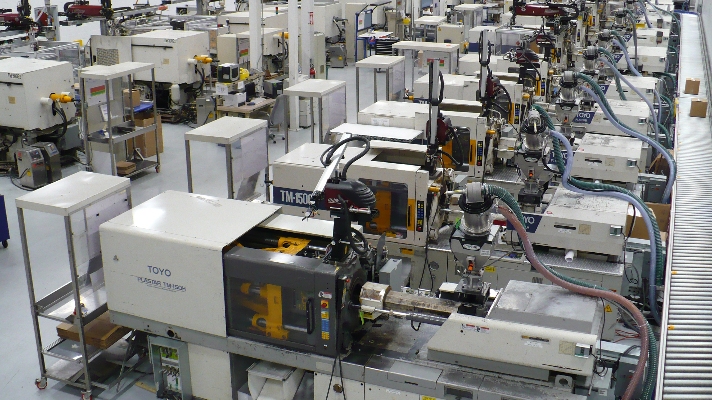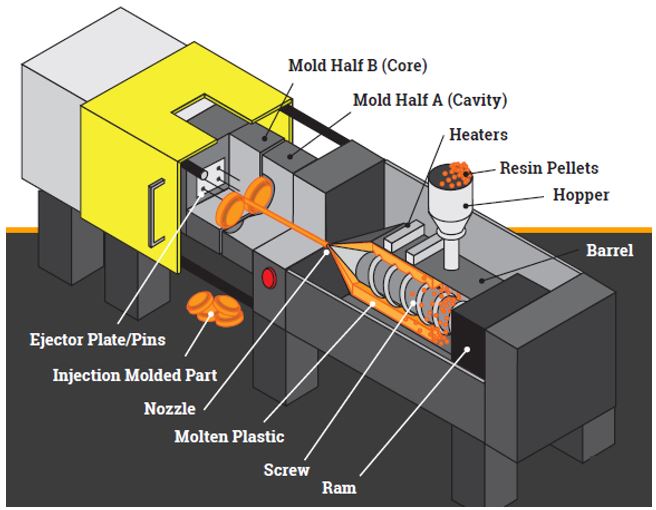The Future of Plastic Injection Molding: Technologies and fads to View
As the plastic shot molding market advances, numerous vital fads are emerging that guarantee to reshape its landscape. Automation and clever production techniques are readied to enhance performance, while the change in the direction of lasting products reflects an expanding ecological consciousness. Innovations in 3D printing are leading the way for unmatched design adaptability. These innovations also bring forth obstacles that call for cautious consideration. Recognizing exactly how these aspects will interact and affect future techniques is important for stakeholders wanting to browse this transformative period efficiently.
Automation and Smart Production
As the plastic injection molding sector develops, automation and smart manufacturing are taking center phase, transforming manufacturing procedures - Plastic Injection Molding. The integration of sophisticated technologies such as robotics, IoT (Net of Points), and man-made intelligence is enabling suppliers to improve effectiveness, lower operational expenses, and boost item quality. Automated systems enhance operations, lessening hands-on treatment and enhancing throughput, which is vital in satisfying the increasing need for rapid production cycles
Smart producing technologies assist in real-time monitoring and data analysis, allowing firms to maximize equipment efficiency and anticipate upkeep demands. This aggressive approach not only minimizes downtime however additionally expands the lifespan of equipment. Furthermore, using collaborative robots, or cobots, improves the flexibility of manufacturing lines, making it possible for devices and workers to operate side by side securely and effectively.
The fostering of automation in plastic injection molding is not simply a fad however a critical necessary for organizations intending to remain competitive in a global market. By utilizing these innovations, producers can accomplish greater precision, minimize waste, and adapt swiftly to changing client needs, placing themselves for sustainable development in a progressively computerized future.
Lasting Products and Practices
The push towards automation and clever manufacturing has led the way for a higher emphasis on lasting products and practices within the plastic injection molding sector. Business are increasingly seeking eco-friendly choices to standard petroleum-based plastics, resulting in the adoption of recycled and bio-based products. These lasting products not only lower environmental effect however likewise align with consumer need for greener products.

Moreover, collaboration in between manufacturers, product suppliers, and environmental companies is cultivating technology in the growth of lasting materials that fulfill performance requirements without endangering quality. As policies around plastic use end up being more stringent, the industry is poised to adjust by welcoming these lasting methods, ensuring lasting practicality and reducing reliance on non-renewable sources. The assimilation of sustainability right into plastic injection molding is not merely a trend; it is coming to be an essential element of company responsibility and functional quality.
Breakthroughs in 3D Printing
Current improvements in 3D printing modern technology are dramatically changing the landscape of plastic shot molding. Difficult or as soon as difficult to achieve through traditional methods, the assimilation of additive production procedures permits for the rapid prototyping of complex geometries that were. This ability not just accelerates item growth cycles however likewise minimizes product waste, aligning with the expanding demand for lasting manufacturing practices
Additionally, the emergence of crossbreed production techniques, which integrate 3D printing and injection molding, uses makers the capability to produce complex layouts while preserving the efficiency of automation. This strategy makes it possible for the manufacturing of personalized parts customized to specific customer requirements without compromising the speed and scalability that shot molding gives.
Furthermore, developments in materials, such as high-performance polymers and composites specifically made for 3D printing, are enhancing the useful capabilities of printed components. These products can endure higher stress and show improved thermal properties, making them suitable for even more demanding applications.
As 3D printing continues to progress, its integration right into plastic injection molding procedures promises to enhance productivity, decrease expenses, and foster development in product layout, positioning producers to much better satisfy the challenges of a competitive market.
Data Analytics and IoT Assimilation
Data analytics and the combination of the Internet of Points (IoT) are changing plastic injection molding by providing makers with extraordinary understandings into their procedures. By leveraging real-time data collected from interconnected machines and sensors, suppliers can monitor performance metrics, determine inadequacies, and optimize manufacturing procedures. This data-driven technique facilitates anticipating maintenance, reducing downtime you could look here and expanding devices look here life-span.
Furthermore, IoT assimilation permits boosted quality control. By continuously tracking variables such as cycle, temperature level, and stress times, producers can promptly spot discrepancies from established specifications and make changes in actual time. This not just improves item consistency however also decreases waste and scrap prices.
The blend of data analytics and IoT technologies likewise encourages producers to embrace even more dexterous manufacturing methods. With access to extensive information analytics, organizations can react to market demands with greater adaptability, adjusting manufacturing routines and setups as needed. This adaptability is crucial in a rapidly altering production landscape.

Modification and Design Adaptability
How can modification and design adaptability improve the competitiveness of plastic shot molding? Customization enables suppliers to fulfill particular client demands, accommodating unique dimensions, forms, and performances that standard products might not fulfill.
Improvements in style technologies, such as computer-aided style (CAD) and rapid prototyping, additional bolster this trend. These devices allow developers to create complex geometries and elaborate patterns, which can be perfectly integrated right into the production process. Because of this, manufacturers can respond swiftly to changing consumer preferences and market needs.
Furthermore, the execution of modular tooling systems enhances design versatility, permitting quicker modifications in between various item layouts without extensive downtime. This versatility can result in lowered preparations and lower manufacturing prices, making companies much more affordable and active. Inevitably, accepting personalization and style adaptability in plastic injection molding not just raises item offerings yet also enhances market positioning in an ever-evolving landscape.
Conclusion
The future of plastic shot molding is identified by substantial improvements in automation, lasting techniques, and innovative materials. The integration of IoT Your Domain Name and information analytics will boost functional effectiveness and anticipating upkeep. The fostering of recycled and bio-based products, along with progression in 3D printing, will certainly foster sustainability within the sector. Customization via modular tooling and quick prototyping will enable suppliers to stay responsive and affordable to the dynamic demands of the market.

The future of plastic shot molding is characterized by substantial developments in automation, sustainable methods, and ingenious products.
Comments on “How Plastic Injection Molding Drives Performance in Automation”